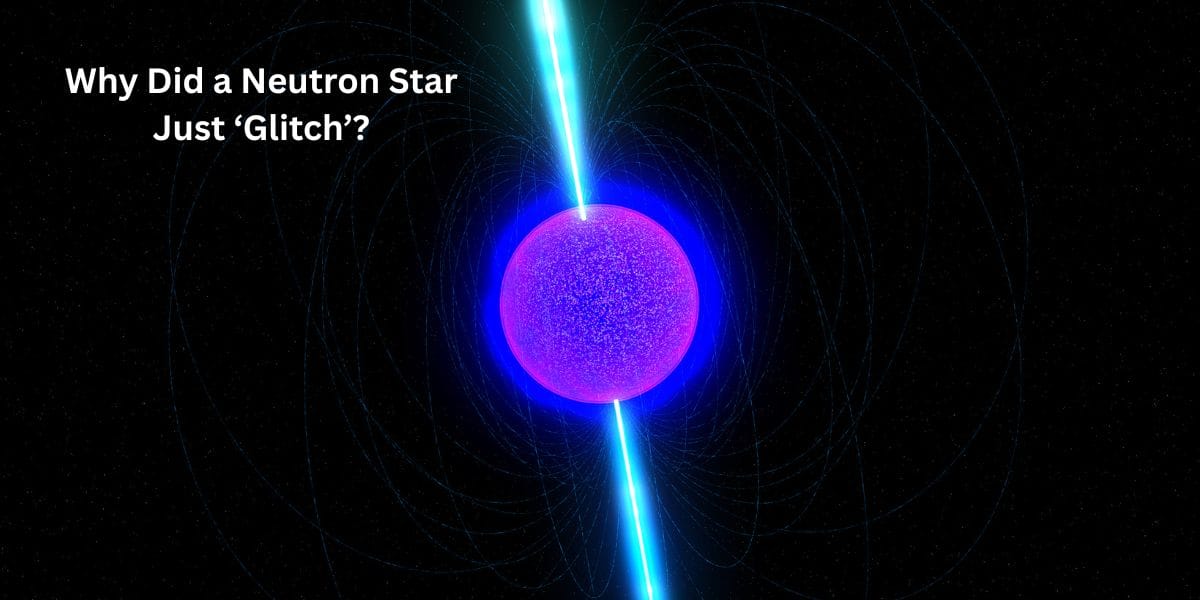Have you ever seen a spinning top wobble suddenly? Imagine a star doing the same thing—but in space! Recently, scientists noticed something strange: a neutron star suddenly changed its speed. This unexpected jump is called a “glitch.”
Neutron stars are some of the most extreme objects in space. They are tiny but super heavy—just a spoonful of their material would weigh as much as a mountain! They spin incredibly fast, some hundreds of times per second. But sometimes, they speed up or slow down without warning.
So, why did this neutron star glitch? And what does it mean? Let’s find out!
What Is a Neutron Star?
A neutron star is what’s left after a big star explodes in a supernova. When a massive star dies, its core gets crushed into a tiny, super-dense ball.
- Size: Only about 12 miles (20 km) wide—smaller than a city!
- Density: So heavy that a sugar-cube-sized piece would weigh a billion tons on Earth.
- Spin: Some spin hundreds of times per second, flashing like a cosmic lighthouse.
Neutron stars are like cosmic magnets, too. Some have crazy-strong magnetic fields, trillions of times stronger than Earth’s!
What Is a Neutron Star Glitch?
A glitch is when a neutron star suddenly spins faster or slower. Think of it like a spinning ice skater pulling their arms in—they spin faster. But in space, scientists aren’t always sure why it happens.
Why Do Glitches Happen?
Scientists have a few ideas:
- Starquake: The star’s crust (outer layer) cracks, like an earthquake, making it spin faster.
- Superfluid Inside: The inside of a neutron star may have a weird, frictionless liquid that suddenly moves and changes the spin.
- Magnetic Forces: The star’s super-strong magnetic field might twist and affect its rotation.
Glitches don’t hurt the star, but they help scientists learn more about how these strange objects work!
How Do Scientists Detect Neutron Star Glitches?
Neutron stars often send out beams of light or radio waves as they spin. Scientists use big telescopes to catch these signals.
- Pulsars: Some neutron stars flash like lighthouses. If the flashes come faster or slower, scientists know something changed.
- X-ray Telescopes: Some neutron stars glow in X-rays. A sudden change in brightness can mean a glitch happened.
When a glitch is detected, astronomers quickly study it to figure out why it happened.
Has This Happened Before?
Yes! Neutron star glitches are rare but not new.
- The Vela Pulsar: One of the most famous glitching stars. It has a glitch every few years.
- The Crab Pulsar: Another well-known neutron star that glitches often.
Each glitch helps scientists understand neutron stars better.
Could a Neutron Star Glitch Affect Earth?
No! Neutron stars are very, very far away. Even if one glitches, it won’t hurt us.
- The closest known neutron star is about 400 light-years away.
- Their glitches don’t send dangerous radiation or anything harmful toward Earth.
So, no need to worry—it’s just a cool space mystery!
What Can We Learn from Neutron Star Glitches?
Studying glitches helps scientists answer big questions, like:
- What’s inside a neutron star? (Is it solid? Liquid? Something else?)
- How do super-strong magnetic fields work?
- What happens when matter is squeezed that much?
Every glitch is like a clue, helping us understand the universe better.
Final Thoughts
Neutron stars are some of the weirdest and most amazing things in space. When they glitch, it’s not a mistake—it’s a chance for us to learn more about how they work.
Who knows? Maybe the next big space discovery will come from studying one of these strange spin jumps!
📌 Frequently Asked Questions
What happens if a neutron star hits Earth?
If a neutron star came close to Earth (which won’t happen), its gravity and radiation would be deadly. But don’t worry—the closest one is hundreds of light-years away!
Can a neutron star turn into a black hole?
Yes! If a neutron star gets too much mass (like if it collides with another star), it can collapse into a black hole.
How fast do neutron stars spin?
Some spin hundreds of times per second! The fastest known spins 716 times per second.
Are neutron stars hot?
Yes! They start at millions of degrees but cool slowly over billions of years.
Can we see neutron stars from Earth?
Some neutron stars, called pulsars, flash light that we can detect with telescopes.
How are neutron stars and black holes different?
Neutron stars are super dense but have a surface. Black holes have no surface—everything gets sucked in!
What is inside a neutron star?
Scientists think it’s mostly neutrons, with a possible liquid or solid core.
Do neutron stars explode?
Not usually, but if two neutron stars collide, they can create a huge explosion called a kilonova.
How long do neutron stars last?
They cool down over billions of years but don’t just disappear.
Could life exist near a neutron star?
No! The radiation and gravity are too extreme for any known life to survive.

You Might Also Like
Betelgeuse Supernova Countdown Latest
What If Sagittarius A Disappeared?
Why Are Wolf-Rayet Stars So Violent?
What If You Fell Into a Tiny Black Hole?